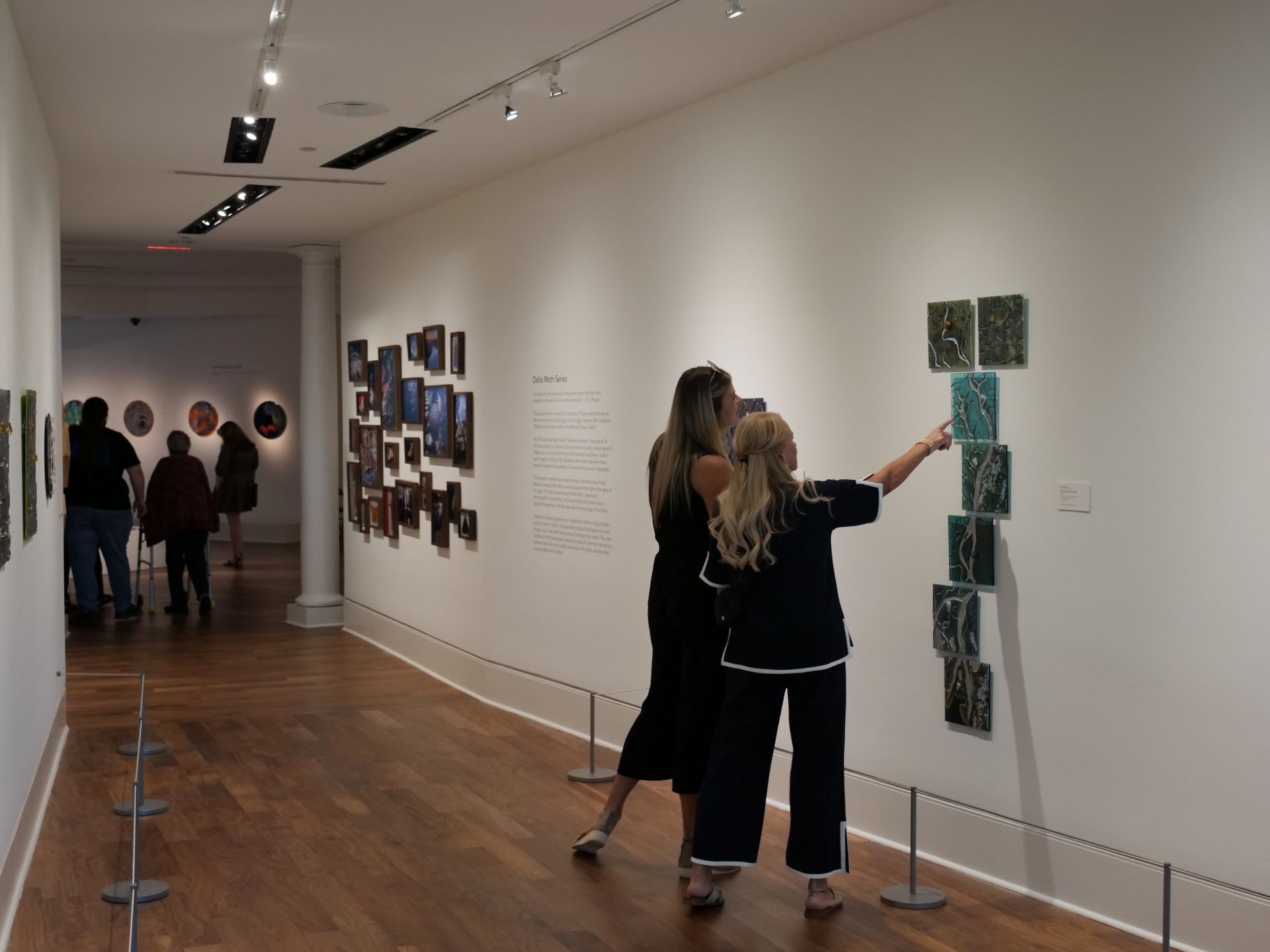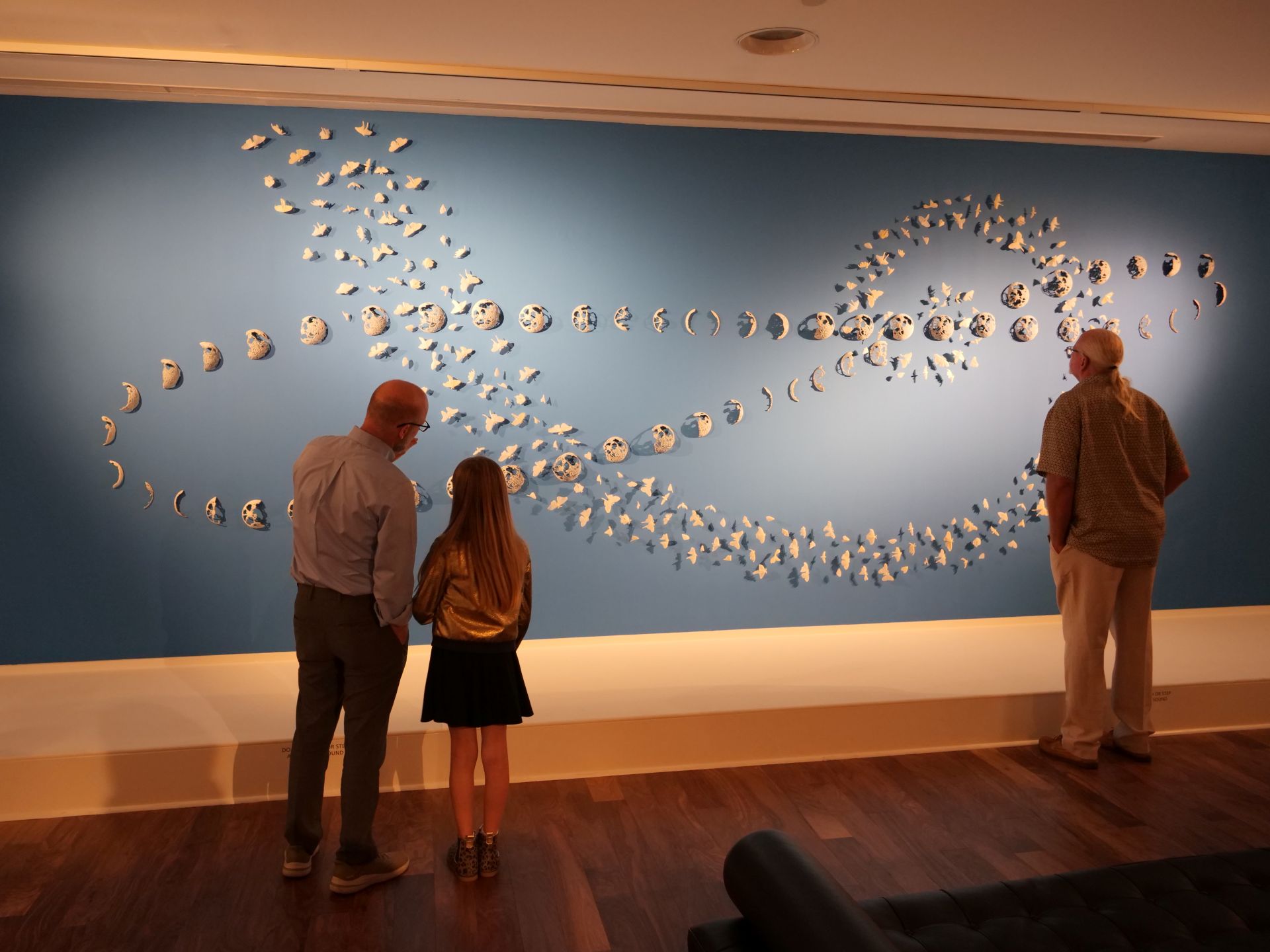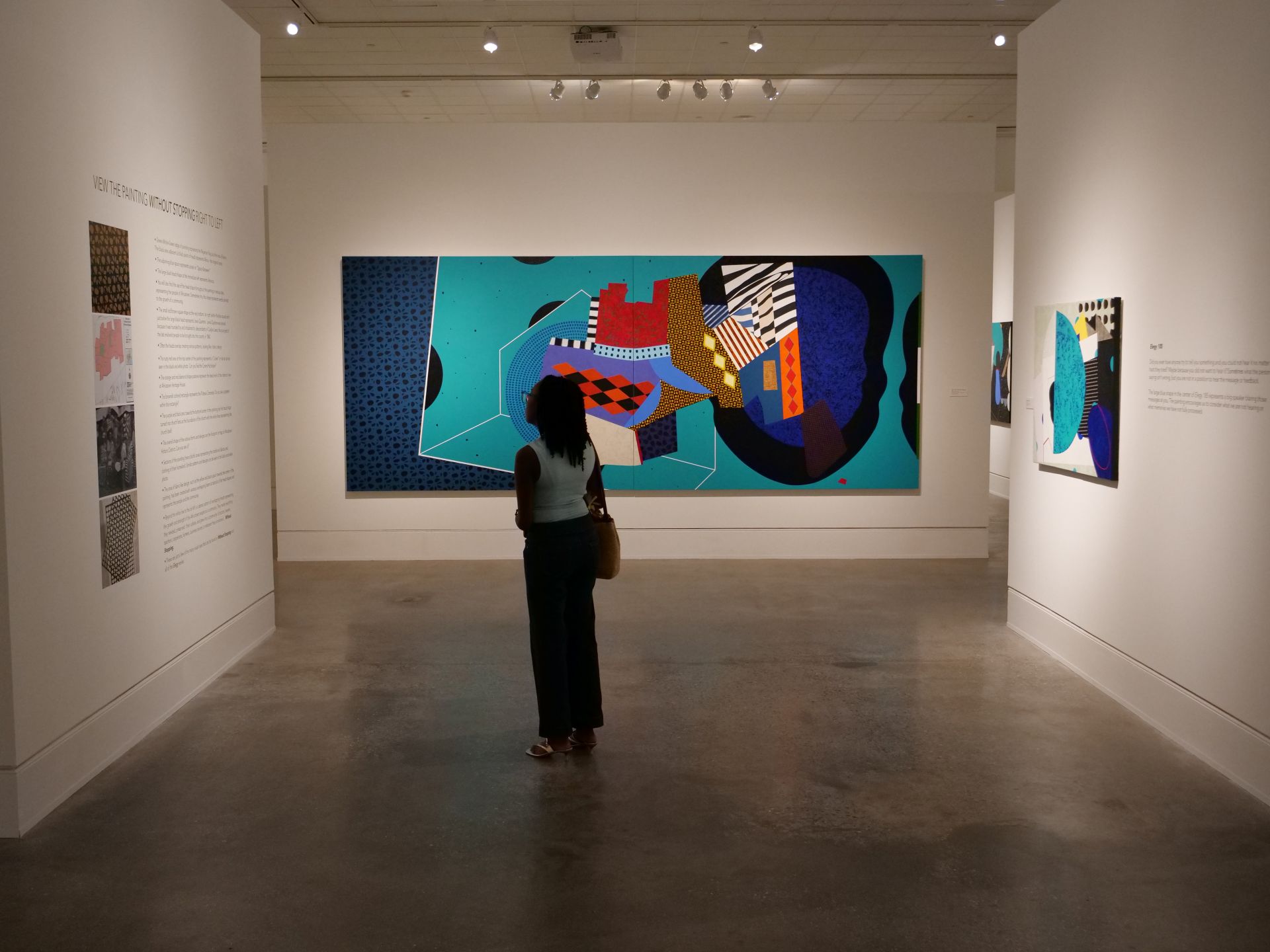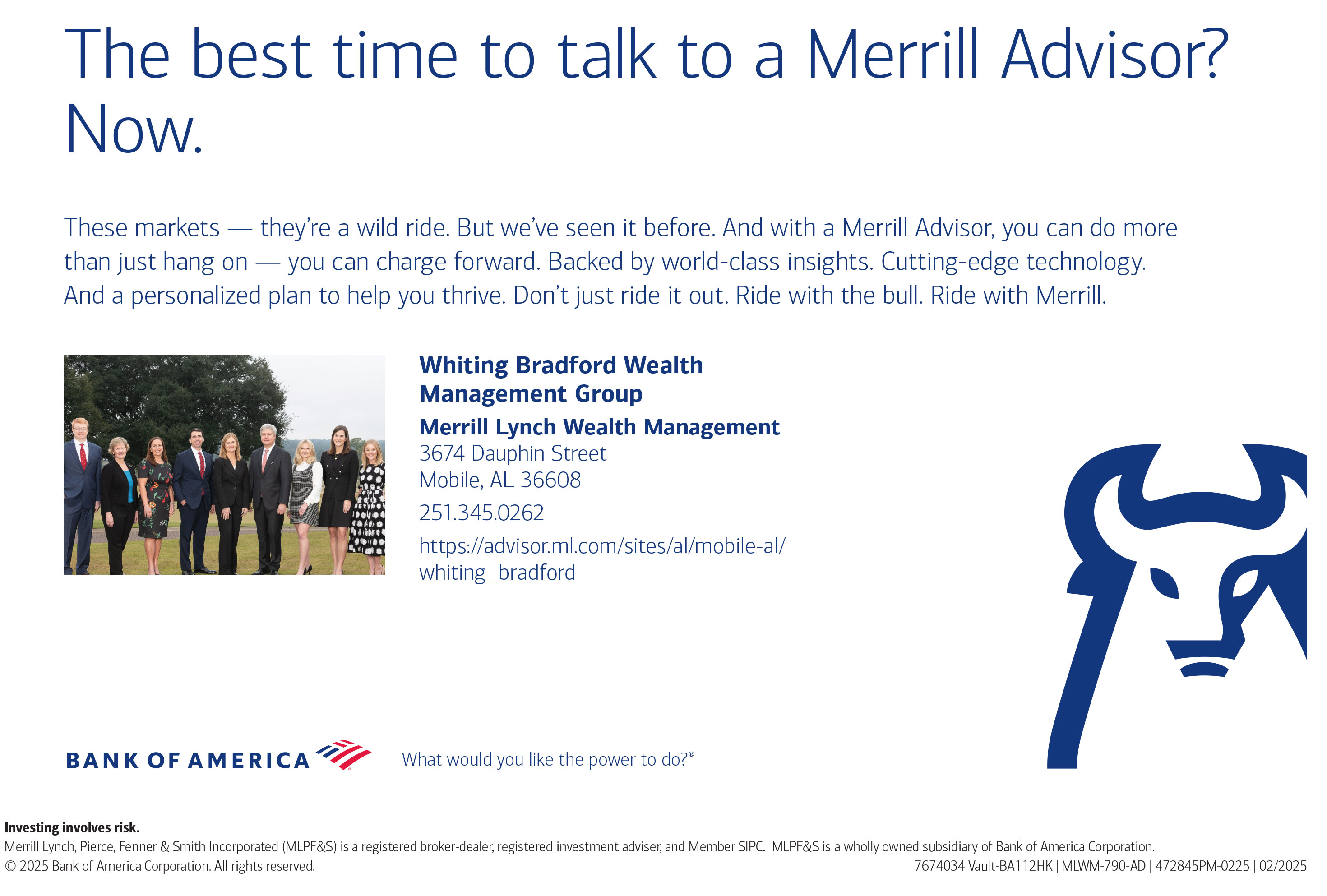
On a recent visit to Mobile’s Museum of Art, as I entered from the picturesque lobby overlooking Municipal Park, I was taken aback by the immersive experience of the two main exhibits on display. The hallway leading into the main gallery begins the journey. Cryptic Underwing is a glass and mixed-media exhibit created by local Fine Arts Professor at the University of South Alabama, Rachel Wright.

The exhibit features her sculptural work, which depicts the Mobile-Tensaw Delta, using ceramics, glass, photographs, and textiles. Moths in shadow boxes are on one side of the space, going down an incline to the main gallery. On the other wall are mosaics of the Delta’s rivers and islands from different overhead perspectives.
It is an amazing immersion into the natural world, as seen through the creative genius of Rachel. The description of each piece tell the story. Upon entering the main gallery, a large sculpture is in the center, highlighted by a ceramic scene on the blue wall behind. It shows how moths in the Delta are governed by moon phases. The exhibit tells a story that few people are aware of.

Rachel and her husband, ceramic artist and Fine Arts professor at South, Tony Wright, have spent a lot of time camping in the Delta in order to better understand its impact. It is not a hospitable place to overnight, yet they take lights to attract the moths, study their habits, and understand how they respond to Mother Nature. The result is an awe-inspiring exhibition with many incredible sensory elements.

The work is striking and is a testament to the artistic endeavor and creativity found throughout the Mobile Museum of Art. The adjoining exhibit is equally remarkable. Juan Logan's "Without Stopping" is a timely series of powerful paintings that questions, creates conversations, and fosters empathy about the world we live in.
This particular series of over 200 works of art is called Elegies. It explores the artist’s memories of pivotal contemporary themes of race, place, identity, and social mobility. The art is bold, with rich, deep colors that strike the senses and open the mind as you read the descriptions and thoughts behind each piece.
Seeing these exhibits for the first time made me want to come back and take time to explore everything the Mobile Museum of Art has to offer. Each exhibit was clean, crisp, pleasing and impressive and had a profound effect on me.

A few weeks ago, I met Executive Director Jon Carfagno at a small retirement celebration, and he invited me to come to the Museum for a visit. We had planned to sit down so I could interview him for a story, but I was so taken by the art and extraordinary feel of the place that we never had a chance to visit. I returned later and was equally impressed by Jon’s story. I left feeling very fortunate to have someone with Jon’s vision and passion leading the Mobile Museum of Art, now in its 60th year.

Jon grew up in central New Jersey, just outside of Princeton. He graduated from Holy Cross University with degrees in Art History and German. He studied German from sixth grade through college, and I asked how this came to be. “In the 6th grade, the class studied different countries, and when they were doing Germany, they had pretzels, gummy bears, and we learned about Oktoberfest. All my friends thought Germany was cool, so, in the 7th grade, I decided to study German as a language.”
This part of his story, Jon credits to divine intervention. His dad died in a car accident on September 4, 1995, 30 years to the day we were visiting. “I was a really dumb hockey player and baseball player, and had just made varsity cross-country when my dad died. Because I was a three-sport athlete, I was waived from having to take a Physical Education class, but had to choose an elective. I chose German Romantics in Advanced Art History.”
At 16 years old, Jon knew he wanted to work in a museum. “I saw a painting, Monk by the Sea, by Caspar David Friedrich, painted in 1810. It captured exactly how I was feeling, trying to comprehend something I had experienced after my father passed away.”
His mother gave him a book about the artist for his 17th birthday. “I devoured it. I wanted to be immersed in art and wanted to share the experience with as many people as possible. Engaging with art can be a life-changing experience.”
In his junior year of college, Jon earned an internship in Berlin at the Markish Museum. In a stroke of good fortune, he was assigned to catalog and report on the condition of 490 works donated to the museum by the daughter of Jacob Steinhard, a German artist. He was told by his director, “This will be good for your German, since you will have to translate this body of work for my catalog.”
At Holy Cross, his professors encouraged Jon, telling him he had a special talent for art history.
After graduation, Jon earned his graduate degree in Art History from the University of Massachusetts. He was awarded a Fulbright Teaching Scholarship to study in Austria. Because of his proficiency in German, he was given a second-year teaching assignment. “Things just lined up for me. My German was the catalyst that opened a lot of doors.”
After college, he became a museum curatorial assistant in Connecticut, working with the Curator of American Art. Later, he worked in the education department at the Museum of Fine Arts in Houston, collaborating with K-12 teachers to help them integrate the museum’s art collection into their classrooms. The Gulf Coast American History Association offered grants that sent high school teachers to the museum to earn certificates, many of whom were football coaches who were required to teach art in the classroom as a default subject.
“I learned an awful lot about how to communicate to help audiences connect with art. Our team’s job is to make as many people as possible have access to these experiences, to see the world anew.” Jon explains his goal was to introduce art as a relevant and important thing in life and invite everyone to participate. He wanted art to be interactive, and created programs and access for all ages and backgrounds.
In 2005, Jon married Megan from Petoskey, Michigan, near Grand Rapids. At the wedding, Megan’s cousin suggested they visit the Grand Rapids Public Museum, the first LEED Gold-certified environmental museum. So taken by the experience, Jon made the comment, "If they ever have an opening, I promise I’ll apply.” Four months later, the position of Director of Education was posted.
Jon accepted the position in 2009 and was responsible for developing educational programs. “This is where my combination of personal interest, passion, and opportunity intersected. Grand Rapids isn’t a Rust Belt city. In fact, it is the home of many innovative and creative corporations that have worked closely with the Museum to advance operations management systems, improving productivity across any organization.”
“I spent a lot of my time at a corporate innovation incubator called Grid 70, a co-working complex. It was the most creative environment I have ever experienced, with all these multi-million dollar corporations' best creative thinkers collaborating together on big projects. It was an amazing opportunity.”
While there, Jon earned his MBA at Kendall College of Art and Design and became certified as a Level II Practitioner from AmWay’s Business Innovation Curriculum. “It was an amazing place for learning creative economics. The mindsets and methodologies that I learned in Grand Rapids comprise the systems we use today at the Mobile Museum of Art.”
Jon’s next stop was the Hickory Museum of Art in Hickory, North Carolina, an area known for its furniture design and manufacturing. “Furniture people are generally people who love art and design. I went from the contract furniture manufacturer, Herman Miller, in Grand Rapids, to the domestic furniture manufacturer experience in Hickory. From an operations standpoint, we developed two successful strategic plans, both perfectly human-scaled.”
When his predecessor announced her retirement from the Mobile Museum of Art, Jon accepted the position and began on Valentine’s Day in February 2023. “I’m a superstitious Italian, and my start date at the Hickory Museum of Art was April Fool’s Day. That always bothered me.” Following a series of full-team meetings that conducted internal and external analyses, the Board approved and adopted the new strategic plan in December 2023.
“We’ve brought the operations management planning program I learned in Grand Rapids to the Mobile Museum of Art, and we are the only museum of this size to utilize this system. The operation is as efficient and productive as can be, and has resulted in a bold, ambitious programming.”
Jon says that during their due diligence phase, the frontline team members, those who serve as security, janitorial, and other services who encounter the public, wanted to learn more about the exhibits themselves, so they could better interact with the public and answer questions. He shows me the plan on the wall of the administration area, which is updated daily for everyone to see and contribute. “It’s our living, breathing playbook.”
The results are evident in my visit to the Museum. Exhibits are vibrant and inviting with clear, clean descriptions of the art. The building is bright and cheerful and the art is exceptional. “We have the same issues inherent to any museum, and we address those like a rose bush. Rose blossoms are what we like about our exhibits already. Thorns are the things we wish were different. And bugs are the ideas we have for the future.”

As former Executive Director, Deborah Velders said as she passed the torch to Jon, “Museums now are more about people and communication. Now is the time to throw open the doors, get out of the way, and fly.”
Jon and his team are up to the task. The numbers speak for themselves. Jon beams with pride that overall attendance is up, visitors represent a much more diverse group, and more school groups are attending programs. His enthusiasm for the art world and his place in it is infectious.
“Art is for the people. You don’t have to be an art historian to appreciate its impact. Everyone sees different inspiration in art. We are excited about the future and have a unique system in place with everyone on board to make it happen.”
Thank you, Jon. We are fortunate that the path that began in the 6th grade has led you here!
























